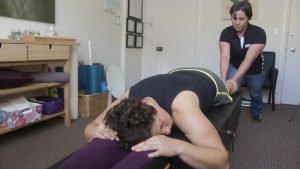
You may have heard sports chiropractors and massage therapists talking about different modalities to treat soft tissue injuries like sports injuries and repetitive use injuries. Terms like deep tissue massage, Active Release Techniques, and Graston Technique are thrown around frequently here in Oakland. But how do you know what will work best for you, or even what you will prefer? Let’s breakdown two of the most common therapies performed by a sports chiropractor, Active Release Techniques and Graston Technique, and see which comes out ahead!
Active Release Techniques
This technique does not require any tools other than the practitioner’s hands. There are protocols for almost every muscle, ligament, and tendon in the body, and there is even an advanced set of protocols to treat nerve entrapments at many sites. Injuries like carpal tunnel syndrome, plantar fasciitis, tennis and golf elbow, swimmer’s shoulder, shin splints, hip and knee pain, and sciatica can all be resolved successfully with Active Release Techniques. For any particular protocol, the involved muscle is first placed in the shortest possible position. The sports chiropractor then takes a hand or thumb contact on the problem area in the muscle tissue, and holds this contact with tension vectored in a specific direction, as the patient moves the body part so that the muscle is lengthened. The Active Release Techniques protocols reduce adhesion in the muscles and other tissues, resulting in less pain and better function. If you’ve had a deep tissue massage, you will recognize some of the same sensations during this treatment, it’s not painful, but it\’s not always comfortable either. Most patients will report that they feel a “good hurt” sensation during the treatment, and that the muscle usually gets less tender as the adhesion starts to lessen. Active Release Techniques is a great chiropractic treatment that restores functional movement.
Graston Technique
This technique uses a set of metal tools to breakdown adhesions in overworked muscles and ligaments. The resonant quality of the metal allows the sports chiropractor to “feel” the adhesions in the tissue due to vibrations through the tool. Your practitioner will already have a good sense of where the adhesions are through the exam and manual palpation, but this extra sense is a nice bonus once treatment is started. Depending on pain tolerance, treatment location, and severity of injury, you will feel something on a spectrum of nothing to oh-my-gosh-must-keep-breathing-that-is-painful! The area will generally become warm as adhesion is removed, and you may see petechia (small red dots) forming on the skin surface which is evidence of adhesions breaking up. There are different shaped tools for different body parts, and when choosing a tool, consideration is given to how deep or how superficial the problematic muscle is. A lubricant is used with the tools to provide the right amount of friction against the skin, and is based on yours and the sports chiropractor’s preference. Common choices are coconut oil, deep tissue cream/lotion, Biofreeze, and the lotion that is sold with the Graston tools.
Conclusion
Patients usually feel more sore after a Graston treatment than an Active Release Techniques, however many people report quicker results with Graston. Graston occasionally leaves some bruising, so if there is any reason that might be inappropriate for you, be sure to let your practitioner know at the start of the treatment. Some patients find the “scraping” sensations of the Graston tools like nails on a chalkboard, and others remark that it feels very therapeutic. Both techniques can be modified to fit the individual and the situation, so there is never more pressure than you feel comfortable with. A good Oakland sports chiropractor will rely on their experience to choose the best technique(s) for your particular injury, while reasonably accommodating your personal treatment preferences.
If you have any questions about Active Release Techniques or Graston Technique, please call us at (510) 465-2342.
